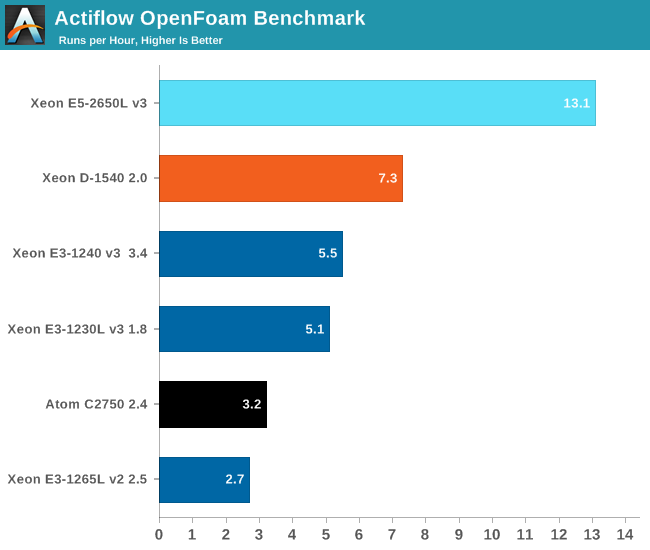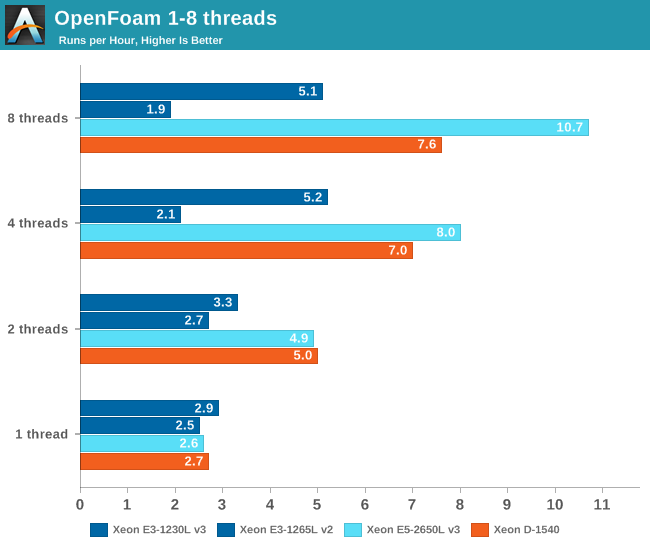The Intel Xeon D Review: Performance Per Watt Server SoC Champion?
by Johan De Gelas on June 23, 2015 8:35 AM EST- Posted in
- CPUs
- Intel
- Xeon-D
- Broadwell-DE
OpenFoam
Computational Fluid Dynamics is a very important part of the HPC world. Several readers told us that we should look into OpenFoam and calculating aerodynamics that involves the use of CFD software.
We use a realworld test case as benchmark. All tests were done on OpenFoam 2.2.1 and openmpi-1.6.3.
We also found AVX code inside OpenFoam 2.2.1, so we assume that this is one of the cases where AVX improves FP performance.

HPC code is where the Xeon E5 makes a lot more sense than the cheaper Xeons. The Xeon E5 is no less than 80% faster with 50% more cores than the Xeon D. In this case, the Xeon D does not make the previous Xeons E3 look ridiculous: the Xeon D runs the job about 33% faster. Let us zoom in.

OpenFoam scales much better on the Xeon E5, and we've seen previously that a second CPU boost performance by 90% offering near linear scaleability. Double the number of cores again and you get another very respectable 60%. Eight cores are 34% faster than four, and 4.1 times faster than one.
Compares this to the horrible scaling of the Xeon E3 v2: 4 cores are slower than one. The Xeon E3 v3 fixed that somewhat, and doubles the performance over the same range. The eight cores of the Xeon D are about 2.8 times faster than one - that is decent scaling but nowhere near the Xeon E5. There are several reasons for this, but the most obvious one is that the Xeon E5 really benefits from the fact that it has almost twice the amount of bandwidth available. To be fair, Intel does not list HPC as a target market for the Xeon D. If the improved AVX2 capabilities and the pricing might have tempted you to use the Xeon D in your next workstation/HPC server, know that the Xeon D can not always deliver the full potential of the 8 Broadwell cores, despite having access to DDR4-2133.










90 Comments
View All Comments
zodiacfml - Tuesday, June 23, 2015 - link
this is the reason why Intel focuses on mobile, it benefits their server cpus too.the 14nm process is the one to thank for these massive improvements. Samsung also has 14nm and the S6 Exynos is in similar achievement
Refuge - Tuesday, June 23, 2015 - link
I disagree, the Exynos is no where close to a similar achievement.Granted it is doing better than Qualcomm's equivalent at the moment.
But I'm also faster than a fat man with a broken leg running on a hot and humid day.
zodiacfml - Tuesday, June 23, 2015 - link
Still, these 14nm SoCs are the best in their class as they pack more cores while using less power.LukaP - Thursday, June 25, 2015 - link
Just a note, Samsung's (and TSMC's 16nm FF(+) process isnt really 16nm entirely. The interconnects are still 28nm making it not nearly as dense as intel's 14nm, as well as being more leaky. IIRC their density and leakage can be compared to intels 22nm TriGate in the times of Ivy Bridgenils_ - Tuesday, June 23, 2015 - link
Few questions:1. Why did you disable x2apic?
2. Did the Large Page allocation in the Java Benchmark actually work? It can be a bit tricky some times and then falls back to 4KiB pages
3. What were the JVM settings for elasticsearch?
JohanAnandtech - Thursday, June 25, 2015 - link
1. Was out of the box disabled. I have to admit I did not check that option. Performance impact should be neglible though.2. I have no monitored that, but there was a performance impact if we disabled it.
3. ES_heap_size = 20 G; otherwise standard ES settings
Daniel Egger - Tuesday, June 23, 2015 - link
Wow, that is still quite pricey here. For the price of the SuperMicro tower you can actually get a 1U 2S Xeon E5 system with one socket equipped and some memory. I'd really love to replace my home server (running on Core i5 rather than Xeon E3 for efficiency reasons, those C chipset suck balls) with one of those systems if they can make them efficient and quiet.hifiaudio2 - Tuesday, June 23, 2015 - link
Two questions:1. How does the Xeon D compare to the c2700 series for a home NAS that will also serve as an Emby server and HDHR DVR (when that software is available). Could be one or two 1080p transcodes going on at the same time at most. Usually no transcoding if I am using Kodi or something that can natively play back the file, but for remote viewing or random uses over the network, some transcoding by Emby could be required -- if you are not familiar with Emby think of the same thing using Plex. So would the extra power of the Xeon D be of use to me, or is the 8 core c2750 plenty for the aforementioned use case?
2. If I do go with this unit, which dimms specifically does it use? The Supermicro c2750 board takes laptop style dimms. What does this take?
JohanAnandtech - Tuesday, June 23, 2015 - link
I can answer 2: see the picture here: http://www.anandtech.com/show/9185/intel-xeon-d-re... RDIMMs or UDIMMS (= basically "normal" DDR-4) will do.hifiaudio2 - Tuesday, June 23, 2015 - link
Thanks.. So this ram:?http://www.amazon.com/Crucial-PC4-2133-Registered-...
And what is the SR x4 / DR x8 difference in the two choices for the 8gb sticks?